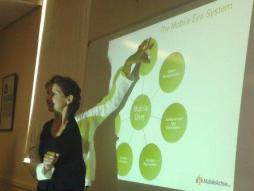This post was originally published at MediaShift by Guy Berger, Rhodes University. Republished under Creative Commons licensed here. Thank you, Guy!
Online computers, Africans do not have. Cellphones are a different story.
So why aren't journalism schools around the continent integrating the use of mobile devices fully and squarely into their courses? It's a question that could also apply in many other places - even in media dense environments.
Answers - and solutions - to this challenge were forthcoming in Grahamstown, South Africa, last week, when MobileActive's Katrin Verclas - a Knight grantee - ran a workshop with a selection of African journalism teachers at Rhodes University.
The participants were brought together under the auspices of another Knight project, the Knight Center for International Media at the University of Miami. Veteran multi-media teacher Rich Beckman had put together five days of high-powered training for a handpicked group from countries as diverse as Sierra Leone, Kenya, Senegal and South Africa.
The group learnt about audio-driven slide shows by MSNBC's Jim Seida, and online video storytelling by the University of Westminster's David Dunkley Gyimah. Debate around digital ethics was led by Sam Terril from the University of Miami.
But it was the session with Verclas that brought home the obviousness of why there should be a strong focus on mobile in African journalism schools. Take Muda Ganiyu, head of the Lagos Polytechnic, who told colleagues that he had seven video cameras for 1200 students. Video-enabled cellphones, he pointed out, could fill a rather large gap.
During the workshop itself, he proved this very point when he and colleague George Nyabuga captured - on a cellphone - dramatic video of a township shack set on fire, and the alleged arsonist being arrested, all done while out on a workshop exercise.
Asked Verclas: "What about the problem that cellphones don't usually have as high end capabilities as specialised video cameras?"
Came the answer: "Having second-rate technology to tell a story is better than no technology at all."
More than this, participant Harold Gess argued, j-teachers need to focus on story-telling, and tech is secondary to this task. Ergo, if a cellphone can enable students to learn to tell stories effectively, that amounts to mission accomplished.
Ayesha Ismail, another participant, added that the value of teaching students to use the power of their phones is that they can then do reporting at any time, and not be constrained to times when they booked out a school's scarce equipment.
That point brought home the importance of students learning to use - to the full - their very own particular phones.
Highlighting the value of capitalising on having a communications tool in your pocket, Verclas herself on the very morning of the workshop snapped pictures on her cellphone of a smashed window at local newspaper Grocott's Mail.
Overnight, thieves had stolen a TV set located in the window bay and which had been part of the Knight supported Citizen Newsroom, launched the previous week during the Highway Africa conference in the city.
Newsroom co-ordinator Michael Salzwedel and editor Steven Lang had also grabbed a picture on their cellphones with the aim of posting it online and generating community discussion around the crime.
Back to Verclas' class. Another participant in the discussion, Brian Garman, proposed that classes on mobile journalism start with minimalist phone capability - teaching the principles of reporting in text via SMS. Courses could then move on and upward to images, audio, video and multi-media packages done on - and sometimes for - cellphones.
Garman also argued that when students had access to higher-end specialist equipment, they tended to replicate genres and formats that were industry-standard. Conversely, if they were required to experiment with the new medium of mobile, there would be a greater chance that they could drive change.
This point put the participants at the workshop into temporary pause mode, the reason being that using cellphones for journalism is as new to them as it is to students.
As realisation of the possibilities set in, it was almost as if the room became energised with light bulbs flashing, brainwaves churning, and spirits soaring.
In assorted projects for Verclas during the day, the group came to grips with practical production using cellphones, and came up with pretty creative content. Like a documentary in French using their mobiles, as well as the shack fire story.
They also cooked up clever schemes for using cellphones in innovative ways and with sexy applications. One idea was to sign up people during the 2010 World Football Cup in South Africa, and at a random SMS signal, trigger an avalanche of user-generated photos of what was happening at that given moment in time.
Another proposal was for software tools that would enable an entire audio slideshow to be edited, compiled and compressed for upload on a cellphone. A third idea planned to enlist carriers to load phones with social mobilisation images and audio, which would kick in to users when calls were made or received.
It wasn't all blue skies, however. Verclas highlighted the importance of context - where powerful cellular carriers can determine what lived or died in cellular space. Metadata about locality can be abused, prices are insufficiently regulated in some countries, and privacy can never be guaranteed.
There's no problem in acknowledging the downside. Journalism teachers need to convey the dystopian dimensions to students as well as the positive potential.
After the workshop last week, now they know they can do both.
Photo courtesy: Guy Berger


Post new comment